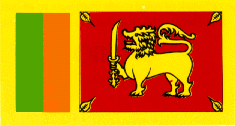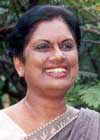SWEDISH SOUTH ASIAN STUDIES NETWORK
Sri Lanka
 Official name: Democratic Socialist
Republic of Sri Lanka (Sri Lanka Prajatantrika Samajavadi Janarajaya).
The name Sri Lanka was adopted in 1972, before which was used Ceylon –
originally a Portugese transcription for the old Pali name Sihala.
Official name: Democratic Socialist
Republic of Sri Lanka (Sri Lanka Prajatantrika Samajavadi Janarajaya).
The name Sri Lanka was adopted in 1972, before which was used Ceylon –
originally a Portugese transcription for the old Pali name Sihala.
Independence: February, 4, 1948,
from United Kingdom
Republic:Since
May, 22, 1972
Area: 65 606 km2.
Administration: The country is divided
in eight provinces; Central, North Central, North Eastern, North Western,
Sabaragamuwa, Southern, Uva and Western.
Capital:Sri Jayewardenepura Kotte
Commercial capital:Colombo
Population:20,926,315 (2007 est.).
The 13th Census of Population and Housing of Sri Lanka on 17th July
2001 could not be completed in the northern and eastern parts of the
country, but regional
statistics are available. An estimation for the whole country was
however made – 18,73 Million.
Since the outbreak of hostilities between the government and armed Tamil
separatists in 1983, several hundred thousand Tamil civilians have fled
the island; as of mid-1999, approximately 66,000 were housed in 133 refugee
camps in south India, another 40,000 lived outside the Indian camps, and
more than 200,000 Tamils sought refuge in the West (according to CIA)
Population growth rate: 0.982
p.c. (est. 2007).
Life expectency: 74.8 years (est. 2007)
 GDP per capita:4,700 US-dollars (est. 2006).
GDP per capita:4,700 US-dollars (est. 2006).
Industrial production growth rate: 6.2 p.c. (2006)
Export products:
Textiles & Apparel, Tea and Spices; Diamonds, Emeralds, Rubies;
Coconut products, Rubber manufactures, Fish
Land use: Arable land: 14%, permanent
crops: 15%, permanent pastures: 7%, forests and woodland: 32%, other:
32% (1993 estimations)
Ethnic groups: Sinhalese 73,96 p.c,
Lankan tamils 12,71 p.c, Indian tamils 5,52 p.c, Lankan moors 7,07 p.c.
Others, including Burghers and Eurasians, 0,76 p.c.
Religious groups: Buddhism 69,30
p.c, Hindus 15,48 p.c, Muslims 7,61 p.c, Christians 7,55 p.c, Others 0,06
p.c.
 National flag:Adopted in 1951. It depicts alion with sword on red bottom.
The lion was the mythical ancestor of the Sinhalese people (sinha
means lion). In the corners are found four leaves from the Bo-tree under
which Lord Buddha sat. On the left side are found two stripes, one orange
and one green, symbolizing the Hindu and Muslim minorities respectively.
National flag:Adopted in 1951. It depicts alion with sword on red bottom.
The lion was the mythical ancestor of the Sinhalese people (sinha
means lion). In the corners are found four leaves from the Bo-tree under
which Lord Buddha sat. On the left side are found two stripes, one orange
and one green, symbolizing the Hindu and Muslim minorities respectively.
National anthem:Namo Namo Matha,
in sinhalese language, composed by Ananda Samarakone, chosen as the national
anthem on 22 November 1951. More
information.
Languages: Sinhalese and Tamil are
both national languages. English is widely used as a link language. The
holy scriptures of Buddhism are written in Pali, whereas the Hindu holy
scriptures are written in Sanskrit.
Sinhalese developed out of a North Indian Prakrit language in the 9th
Century A.D. Sinhalese, Prakrit, Sanskrit and Pali all belong to the Indo-European
linguistic family, whereas Tamil is a Dravidian language.
 President: Mahinda Rajapakshe (Sri Lanka Freedom Party), since 19 November 2005 (photo
to the left). He was previously for one and a half years , April 04 – Nov. 05, Prime Minister
of country. President
Rajapakse’s personal web page.
President: Mahinda Rajapakshe (Sri Lanka Freedom Party), since 19 November 2005 (photo
to the left). He was previously for one and a half years , April 04 – Nov. 05, Prime Minister
of country. President
Rajapakse’s personal web page.
Mahinda Rajapakse was re-elected President in the presidential elections that took place on January 26th, 2010.![]()
 After
1978 the office of president has had a strong executive function in Sri
Lanka. The president is Chief of State as well as Head of the Government
and besides Chief Commander of the Armed Forces; whereas the office of
Prime Minister is a less important position. Between 1994 and 2005 the
President of Sri Lanka was Chandrika
Kumaratunga Bandaranaike (Sri
Lanka Freedom Party – SLFP), photo to the right. She
belongs to one of the most renowned political families of the country.
Both her father S
W R D Bandaranike (murdered in 1959) and her mother Sirimavo
Bandaranaike (who
passed away in the year 2000) were Prime Ministers. She led the coalition
Peoples' Alliance (PA), in which SLFP is the major party, which ruled
Sri Lanka till it was defeated by the UNP in the elections on 6 December,
2001.
After
1978 the office of president has had a strong executive function in Sri
Lanka. The president is Chief of State as well as Head of the Government
and besides Chief Commander of the Armed Forces; whereas the office of
Prime Minister is a less important position. Between 1994 and 2005 the
President of Sri Lanka was Chandrika
Kumaratunga Bandaranaike (Sri
Lanka Freedom Party – SLFP), photo to the right. She
belongs to one of the most renowned political families of the country.
Both her father S
W R D Bandaranike (murdered in 1959) and her mother Sirimavo
Bandaranaike (who
passed away in the year 2000) were Prime Ministers. She led the coalition
Peoples' Alliance (PA), in which SLFP is the major party, which ruled
Sri Lanka till it was defeated by the UNP in the elections on 6 December,
2001.
Parliament:
Parliamentary elections for the 13th Parliament of the Democratic Socialist
Republic of Sri Lankawere held on 2 April 2004.
The parliament has 225 seats, out of which 196 members are elected in
multi-seat constituencies and 29 by nationwide proportional representation.
Partywise distribution:
United People's Freedom Alliance, UPFA, 105 seats. (UPFA is an alliance between President Kumaratunga’s Sri Lanka Freedom Party, SLFP, and the leftist sinhalese-chauvinist Janatha Vimukthi Peramuna, JVP)
United National Party, UNP, 82 seats (including three seats won by its alliance party Ceylon Workers Congress)
Illankai Tamil Arasu Kachchi, ITAK (Tamil National Alliance), 22 seats.
Jathika Hela Urumaya, JHU, 9 seats
Sri Lanka Muslim Congress, SLMC, 5 seats
Up-Country People's Front, UCPF, 1 seat
Eelam People's Democratic Party, EPDP, 1 seat
Prime Minister since
21 November 2005: Ratnasiri Wickramanayake.
Leader of the Opposition: Ranil
Wickremesinghe (United National Party, UNP). Wickremesinghe
became Prime Minister on 9 December 2001 after his party’s
victory in the general elections that year, but had to resign
efter the was defeat in the elections of April 2004.
History: Historical time, i e the
period during which events have been recorded, goes back to 250 BC. At
that time there were both Prakrit and Tamil speaking peoples living on
the island, which both had moved from the Indian mainland. The native
people of the island were the Veddahs.
Up to the 19th Century AD several dynastic states were created in Anuradhapura,
Rohana, Polonnaruva, Jaffna, Dambadeniya, Gampola, Kotte, Sitavaka and
Nuvara (Kandy). The Portugese began to colonize the coastal areas from
1594, the Dutch from 1640 and finally the Brittish from 1795. Neither
the Portugese nor the Dutch managed to conquer the highlands where the
Sinhala king ruled at Nuvara. But in 1815 the Brittish defeated his army
and the monarchy was abolished. In 1833 all the areas of the island were
united into a centralized colonial adminstration, which ruled the island
till Independence in 1948.
| More information on Sri Lanka |
Wikipedia, the free encyclopedia, Sri Lanka
BBC News Country Profile Sri Lanka
The Human Development Report 2009 data on Sri Lanka
The Official Website of the Government of Sri Lanka
The Library of Congress, USA, offers through its Country Studies Web site detailed Information on all Aspects of Countries round the Globe. Look for Sri Lanka. Information contained in the Country Studies On-Line is not copyrighted and thus is available for free and unrestricted use by researchers. As a courtesy, however, appropriate credit should be given to the series. Unfortunately, though, the information on Sri Lanka is not updated since October 1988.
World Bank Group/Sri Lanka: Data reports, statistics, projects etc, for Sri Lanka, including its country report from 2002, ”Sri Lanka: Recapturing Missed Opportunities”.
CIA – The World Factbook 2007: Sri Lanka
Sri Lanka Page offers Latest Hot News from Sri Lanka, updated around the clock
The British Foreign & Commonwealth Office (FCO) advice on safety aspects on travelling to Sri Lanka
The Swedish Government’s Division for Democratic Issues, based at the Ministry of Justice, regularly publishes reports about the human rights situation in countries all over the World. Read the 2007 Report on the Human Rights Situation in Sri Lanka (in Swedish only).
SASNET - Swedish South Asian Studies Network/Lund
University
Address: Scheelevägen 15 D, SE-223 70 Lund, Sweden
Phone: +46 46 222 73 40
Webmaster: Lars Eklund
Last updated
2010-02-02
